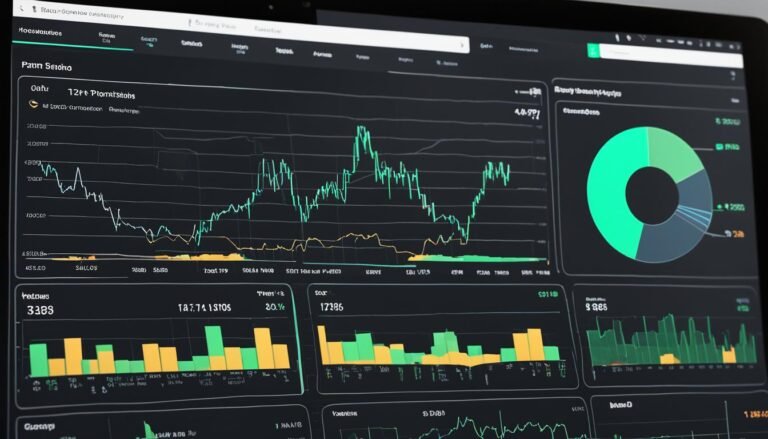Financial Data Analytics Skills: Enhancing Your Expertise
In the world of finance, the ability to interpret, analyze, and draw insights from vast amounts of data is becoming increasingly essential. Financial data analytics skills have become a cornerstone for professionals maneuvering today's complex and dynamic market landscapes.
With technology evolving rapidly, staying current in this field is not just an advantage but a necessity for those looking to remain competitive and relevant. As the demand for experts in financial data analytics continues to rise, honing these skills can open doors to a myriad of opportunities.
Key Takeaways
- Master advanced statistical methods for insightful financial analysis.
- Utilize machine learning for predictive modeling and accurate forecasting.
- Enhance decision-making with data-driven approaches and real-time analytics.
- Continuous learning through industry seminars and certifications for expertise growth.
Importance of Financial Data Analytics
Financial data analytics plays an important role in enabling organizations to make informed and strategic decisions based on quantitative insights derived from financial information. Data interpretation lies at the core of financial data analytics, allowing businesses to extract valuable insights from complex datasets. By analyzing trends, patterns, and relationships within financial data, organizations can gain a deeper understanding of their financial performance and position in the market. This, in turn, empowers decision-making processes by providing stakeholders with accurate and timely information to guide their strategic evaluations.
Effective decision making is heavily reliant on the accuracy and relevance of the data being analyzed. Through financial data analytics, organizations can streamline their decision-making processes by leveraging data-driven insights. Whether it is evaluating investment opportunities, optimizing resource allocation, or managing risks, financial data analytics equips decision-makers with the necessary tools to make sound and informed choices. Ultimately, the ability to interpret financial data effectively is a critical skill that drives organizational success in today's data-driven business landscape.
Essential Tools for Analysis
When delving into the domain of financial data analytics, one must equip themselves with a range of essential tools for thorough analysis. Data interpretation plays a critical role in understanding the meaning behind the numbers. It involves examining datasets to extract valuable insights and make informed decisions.
Statistical analysis is another fundamental tool that aids in uncovering patterns, trends, and relationships within financial data. By applying statistical methods, analysts can assess the reliability of data, identify risks, and predict future outcomes based on historical information.
In financial data analytics, proficiency in tools such as Microsoft Excel for data processing and analysis is indispensable. Excel enables analysts to perform complex calculations, build models, and visualize data through charts and graphs. Additionally, statistical software like R and Python are widely used for advanced statistical analysis, machine learning, and data visualization in the financial sector. These tools empower analysts to handle large datasets efficiently, derive meaningful insights, and communicate findings effectively to stakeholders.
Mastering Data Visualization Techniques
When analyzing financial data, mastering data visualization techniques is essential. Graphical representations play an important role in simplifying complex information for better understanding.
Choosing the right tools and effectively storytelling through data are key components in conveying insights accurately.
Graphical Representation Importance
Mastering data visualization techniques is essential for effectively conveying financial information in a clear and concise manner. Visual storytelling through graphs, charts, and dashboards can greatly enhance data interpretation for financial analysts and stakeholders. Graphical representations offer a quick and intuitive way to identify trends, patterns, and outliers within datasets, enabling informed decision-making processes.
Choosing Right Tools
Proficiency in selecting appropriate tools for data visualization is imperative for mastering data visualization techniques in financial data analytics. When it comes to choosing the right tools, consider the following:
- Select tools based on data complexity
- Utilize tools that offer interactive features
- Guarantee compatibility with statistical analysis software
- Choose tools with customizable visualization options
- Opt for tools that support real-time data visualization
Effective Storytelling Through Data
To effectively convey insights from financial data analysis, mastering data visualization techniques is crucial through the art of storytelling with data. Data interpretation plays a critical role in extracting meaningful information, but visual communication is what truly enhances impact. By utilizing various data visualization tools, financial analysts can present complex data in a clear and concise manner, making it easier for stakeholders to grasp key findings. Effective storytelling through data involves selecting the right charts, graphs, and diagrams to represent the data accurately. This visual representation not only simplifies complex information but also enables a more profound connection with the audience, leading to better decision-making processes.
| Data Interpretation | Storytelling |
|---|---|
| Visual Communication | Impact |
| Clear Presentation | Engagement |
| Chart Selection | Understanding |
Implementing Advanced Statistical Methods
Utilizing advanced statistical methods is essential for extracting valuable insights from financial data analytics. When implementing advanced statistical methods in financial data analytics, several key techniques play a critical role in enhancing the analysis process. These include:
- Hypothesis testing: Conducting hypothesis tests allows analysts to make inferences about the population parameters based on sample data.
- Regression analysis: Regression analysis helps in understanding the relationship between variables and predicting outcomes.
- Data cleaning: Cleaning datasets is important to guarantee the accuracy and reliability of the analysis results.
- Model interpretation: Interpreting statistical models aids in understanding the implications of the analysis and making informed decisions.
- Advanced visualization techniques: Utilizing advanced visualization methods such as heatmaps or interactive plots can enhance the communication of complex statistical findings to stakeholders.
Understanding Machine Learning Applications
Machine learning plays an essential role in financial analytics by enabling the development of predictive models. Understanding machine learning applications in finance allows professionals to harness data-driven insights for informed decision-making.
Exploring the intersection of ML and finance reveals opportunities to optimize trading strategies and risk management techniques.
ML in Finance
Exploring the integration of machine learning techniques in the financial sector reveals profound insights into enhancing decision-making processes and optimizing outcomes. Machine learning (ML) in finance has revolutionized various aspects of the industry, with notable applications in algorithmic trading and risk management. Here are some key points to ponder:
- ML algorithms enable real-time analysis of market data.
- They assist in detecting patterns for more effective trading strategies.
- ML models enhance risk assessment and help in predicting market fluctuations.
- Automated trading systems powered by ML algorithms execute trades swiftly.
- ML tools contribute to the development of sophisticated financial models.
Incorporating ML in finance equips professionals with advanced tools to navigate the complexities of the modern financial landscape efficiently.
Predictive Models
The integration of machine learning techniques in the financial sector has greatly impacted decision-making processes and outcomes, particularly through the development and implementation of predictive models. Model evaluation and feature selection are vital steps in ensuring the effectiveness of these models.
By optimizing algorithms and fine-tuning performance, financial analysts can enhance the predictive power of their models, leading to more accurate forecasts and better-informed decisions. Algorithm optimization involves selecting the most suitable algorithms for specific tasks, while performance tuning focuses on adjusting parameters to improve model accuracy.
In the domain of financial data analytics, mastering predictive models through meticulous model evaluation, strategic feature selection, algorithm optimization, and performance tuning is essential for driving successful outcomes and gaining a competitive edge in the industry.
Enhancing Forecasting Accuracy
To improve the precision of financial forecasting models, incorporating advanced statistical techniques is essential. Evaluating models and performance metrics is vital in ensuring the accuracy of predictions. Time series analysis helps in understanding patterns over time, while trend analysis assists in identifying market trends. Here are five key strategies to enhance forecasting accuracy:
- Incorporate machine learning algorithms for more accurate predictions.
- Utilize ensemble methods to combine multiple models for better results.
- Implement cross-validation techniques to assess model performance.
- Regularly update and refine models with new data to improve accuracy.
- Consider the impact of external factors on forecasting models for a thorough analysis.
Leveraging Big Data Technologies
Leveraging advanced data processing technologies can greatly enhance the efficiency and effectiveness of financial data analytics. Big data technologies enable financial professionals to analyze vast amounts of data quickly and accurately, leading to more informed decision-making processes. By harnessing these technologies, organizations can adopt a data-driven approach, where insights derived from data analysis drive strategic and operational decisions.
Data-driven decision-making empowers financial analysts to base their strategies on concrete evidence rather than intuition. Real-time analytics, made possible through big data technologies, allow professionals to monitor market trends, customer behavior, and financial performance instantly. This capability enables organizations to adapt swiftly to changing circumstances and capitalize on emerging opportunities.
Moreover, big data technologies facilitate the integration of diverse data sources, such as structured and unstructured data, providing a thorough view for analysis. This all-encompassing approach enhances the accuracy of financial forecasts and insights. Overall, leveraging big data technologies is vital for staying competitive in today's dynamic financial landscape.
Continuous Learning and Development
Continuously enhancing skills and knowledge is imperative for financial professionals to adapt to the evolving demands of the industry and remain competitive in the dynamic financial landscape. In the fast-paced world of finance, embracing continuous improvement and skill enhancement is key to staying relevant and effective. Here are five essential strategies for financial professionals to focus on:
- Attend Industry Seminars and Workshops: Participating in relevant events can provide valuable insights and networking opportunities.
- Enroll in Online Courses: Accessing online platforms for courses in data analytics, financial modeling, or other relevant topics can enhance expertise.
- Seek Mentorship: Learning from experienced professionals can offer unique perspectives and guidance for career growth.
- Stay Informed on Industry Trends: Keeping up-to-date with the latest trends and technologies is critical for remaining competitive.
- Obtain Professional Certifications: Acquiring certifications such as CFA or CPA demonstrates commitment to skill development and can boost credibility in the industry.
Conclusion
In summary, mastering financial data analytics skills is vital for professionals in the modern business landscape.
Just as a skilled chef meticulously measures ingredients to create a perfect dish, financial analysts must utilize essential tools, visualization techniques, statistical methods, machine learning, and big data technologies to uncover valuable insights.
Continuous learning and development in this field are akin to sharpening a knife – it is essential for staying competitive and relevant in the ever-evolving world of finance.







